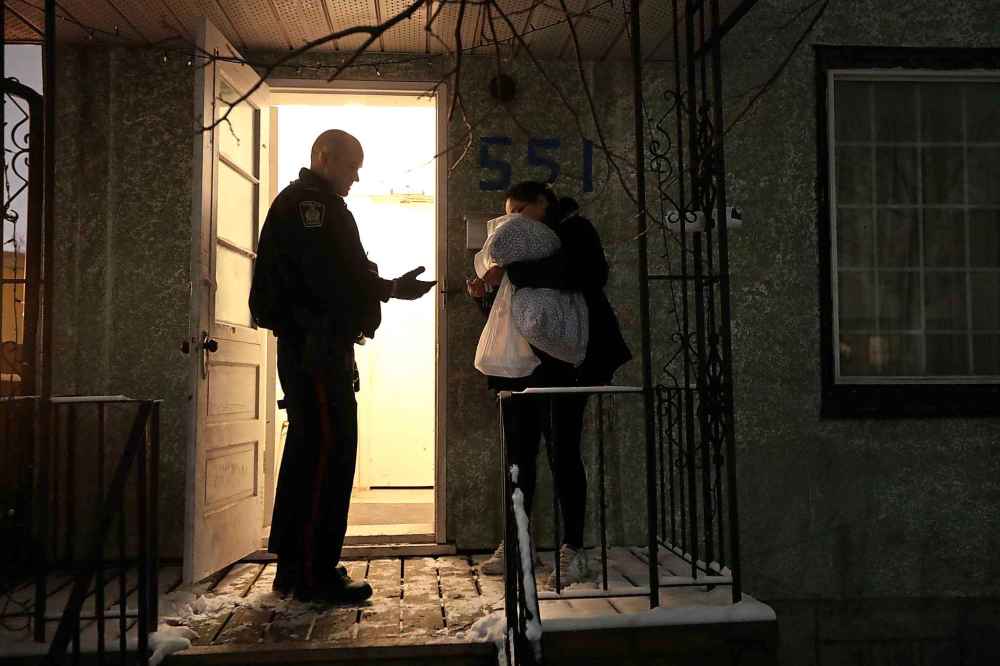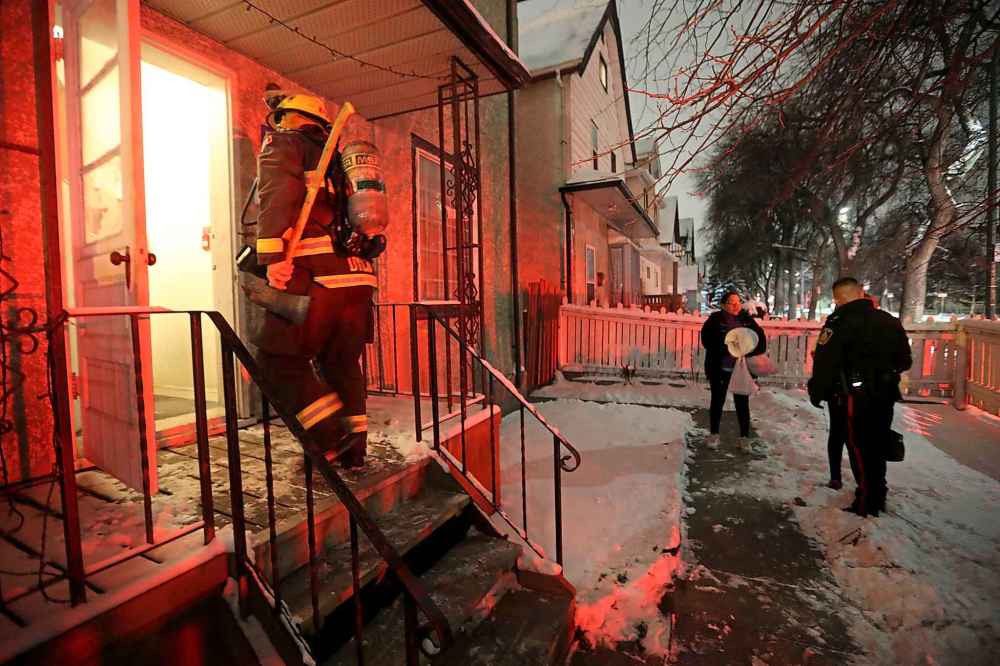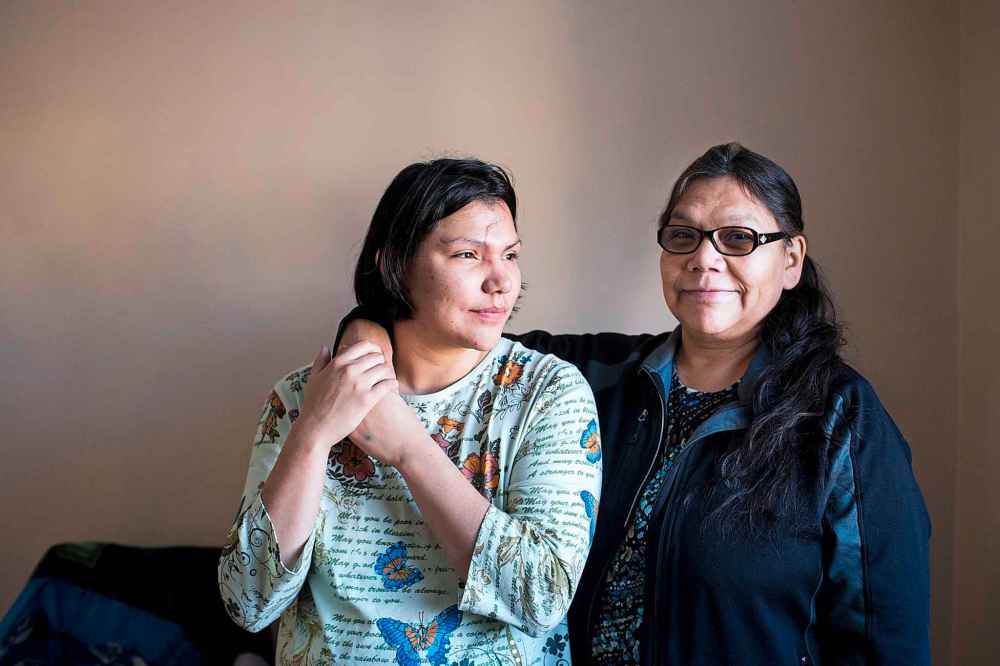Meth, madness and misery Cheap, easy-to-find, incredibly powerful and addictive crystal meth is holding Manitoba hostage
Read this article for free:
or
Already have an account? Log in here »
To continue reading, please subscribe:
Monthly Digital Subscription
$0 for the first 4 weeks*
- Enjoy unlimited reading on winnipegfreepress.com
- Read the E-Edition, our digital replica newspaper
- Access News Break, our award-winning app
- Play interactive puzzles
*No charge for 4 weeks then price increases to the regular rate of $19.00 plus GST every four weeks. Offer available to new and qualified returning subscribers only. Cancel any time.
Monthly Digital Subscription
$4.75/week*
- Enjoy unlimited reading on winnipegfreepress.com
- Read the E-Edition, our digital replica newspaper
- Access News Break, our award-winning app
- Play interactive puzzles
*Billed as $19 plus GST every four weeks. Cancel any time.
To continue reading, please subscribe:
Add Free Press access to your Brandon Sun subscription for only an additional
$1 for the first 4 weeks*
*Your next subscription payment will increase by $1.00 and you will be charged $16.99 plus GST for four weeks. After four weeks, your payment will increase to $23.99 plus GST every four weeks.
Read unlimited articles for free today:
or
Already have an account? Log in here »
Hey there, time traveller!
This article was published 14/12/2018 (2557 days ago), so information in it may no longer be current.
There is smoke in Emily’s house, though she’s the only one who can see it. Smoke, and a man who broke into her room and threw bugs at her. She holds up her arms as she says it, trying to shake the feeling of tiny legs crawling on her.
In the front yard, Winnipeg Police Service Patrol Sgt. Doug Bailey is trying to make sense of it. No, Emily tells him, she hasn’t been using drugs. As they talk, she nervously stares at her back gate.
“See that?!” she exclaims.
Bailey looks. There is nothing but a shadow on the gate. Nothing moving. Nothing that rustles.
“Oh my God,” Emily gasps and, in a flash, leaps to cower behind Bailey, clinging to his arms for safety.

The whine of a siren pierces the night. The quiet West End street is bathed in red lights. A fire truck pulls up near Emily’s house. A firefighter hops off and walks briskly into the yard, where Emily is standing.
“Meth?” she asks, without skipping a beat.
Bailey looks at Emily — who is still staring at the back gate — then back at the firefighter, and hesitates.
“Probably,” the firefighter says, answering her own question.
The first responder knows the routine. She cups Emily’s elbows with her hands — “look at me, look at me” — and faces her. As she speaks to the terrified woman, her voice is bright and efficient. She has done this many times.
“I got you, I got you,” the firefighter says. “Emily, look at me. Do you want to go to the hospital?”
Emily is going to be OK. The firefighters walk her over to the ambulance that will take her to the nearby Health Sciences Centre. She is frightened, but not aggressive or violent, so she won’t need police to escort her there.
Free Press series
ICE STORM
Inside Manitoba’s meth crisis
As he walks back to his police SUV, Bailey points at the line of vehicles on the street. Two fire trucks, an ambulance and two police cruisers. Even straightforward calls such as this one can put a strain on emergency resources.
Does he believe that she hasn’t used drugs? Bailey shakes his head. “She’s definitely on something,” he says.
In Winnipeg, that something is usually crystal meth. In more than 22 years on the job, Bailey has never seen anything like it. Police have always had to deal with intoxicated people, but it’s different with meth, on a whole other level.
“What comes out of their pockets, things they’re yelling about, the bizarre behaviour,” he says. “We started asking, ‘When’s the last time you did meth?’ It’s kind of presumptuous, but nine times outta 10, they’ll say, ‘two days ago.’”
It’s been just over a year since Bailey returned to street policing. Before that, he’d spent five years as a homicide detective. At first, most of the murders he investigated were gang-related; by the end, many were driven by meth.
Investigating meth-related killings is a “totally different animal,” he says. Witnesses struggle to remember whether what they saw was real or a hallucination. Then there is the violence itself, so often rash and inexplicable.
“People get killed in a meth-related homicide for no reason,” he says. “They don’t know why they killed the person.”
But most meth calls aren’t for homicides. The vast majority are for situations similar to Emily’s. Or like the woman Bailey spies an hour later, spinning around a parking lot next to the Salvation Army, shouting as she kicks away at nothing.
“I hate to say it, but it’s become much more normalized,” he says. “People from the suburbs come down, see it and call it in. But unless that person’s a danger to themselves or others, it’s just a person walking down the street yelling.”
There was the incident not too long ago, when someone called to say they heard a woman screaming in a downtown parkade. Police arrived to find her cowering between cars, paralyzed by a terror that could not be soothed away.
In the early days of the meth surge, when the drug was spreading over the city, the panicked calls would send police scrambling to scenes, fearing the worst. Callers using meth often report shocking accounts of violence and stalking.

“If you were going to take every meth user at their word for what they’re telling you, you would be led to believe that every meth user in this city has a group of people chasing them,” one officer says. “And it’s always at about the third, fourth, fifth day after they’ve gone on a binge and haven’t slept in that time.
“And they believe it. They do amazing things to get away from things that aren’t actually happening.”
Over time, police started to recognize the signs. It’s the strange details that pop into the narratives, these sudden bursts of information that are a little too vivid, too bright. Too much like a horror thriller and not enough like real life.
Bailey scrolls through to a call from earlier that afternoon. Someone had called in a panic from a payphone, shouting that seven people had been stabbed by Manitoba Warriors gang members. The killers were sawing the bodies apart.
The caller went on. Someone had escaped through a window. Someone else was running down the hallways taking numbers off apartment doors. The caller swore that an old woman had been killed in the same place a week before.
It wasn’t long ago, Bailey says, you’d have “every unit in the city” rushing to the scene of a reported massacre like that. They’ve grown more skeptical. Sure enough, when they arrived at that call, nobody was in distress and nothing was wrong.

“At first, you’d have Tac(tical Support Team) going into it,” he says. “You’d have all these cars going. Now, I think as time’s gone by, it’s still a high-priority call. People still go, but guys are a little more… ‘OK, that sounds like a meth call.’”
Of course, he adds, you don’t want to get complacent. Because sometimes things do spin out of control.
In August, a man coming down off a meth high taped machetes to his hands and called 911, hoping that police would shoot him (they didn’t.) Days later, a man wordlessly threw a propane tank through a police cruiser’s window.
Last month, three police officers were cut and another assaulted while arresting a woman in a Stella Avenue apartment after she had reportedly been vandalizing cars with a knife.
The officers were treated for “non-life-threatening” injuries, police said in a release. The suspect, 27-year-old Charmaine Grenier, was “reportedly under the influence of methamphetamine.”
This year, those words hang over the city, dominating headlines and lurking in the background of so many lurid news stories. The details change. The words “meth-fuelled” and “meth-induced” appear again and again.
Strange attacks, seemingly random, carried out by people wielding homemade weapons. A slew of break-ins and robberies police believe are the work of meth addicts desperate to finance their next high.
At hospitals, nurses have to defend themselves against punches and kicks from patients in the grips of meth psychosis. More and more, they confiscate weapons: knives, brass knuckles, a baseball bat studded with rusted nails.
It goes on. Needles proliferate through the city, their points sprouting like weeds in sidewalks and parks. Project Safe Audience, a group of volunteer nurses frequently attends Winnipeg raves and offers to test drugs for safety before partygoers take them. In the two years they’ve been offering the tests, the group has found that the vast majority of what is being sold as high-priced cocaine is, in fact, cheap meth.
At the Addictions Foundation of Manitoba, the number of clients who had used meth within the previous 12 months tripled between 2012-13 and 2016-17, a staggering surge that shows no signs of slowing.
The drug has saturated the city; it’s easy to acquire and — for those at risk of exploitation — often free. Users point out places where they can go to get meth, in one case identifying several houses on the very same block.
“If you were going to take every meth user at their word for what they’re telling you, you would be led to believe that every meth user in this city has a group of people chasing them.”
On dating apps, men offer free meth to young women in exchange for sex. It’s even more common for vulnerable girls on the street. These days, “everyone is doing meth,” one user tells the Free Press, a declaration repeated by others.
It is not a quiet drug; it is loud, it is heavy, it weighs services down. Five years ago, Manitoba emergency rooms treated an average of 10 meth overdoses in a month; by the middle of this year, that figure was up to 240.
The effects ripple outward, shaking the city to its core, leaving residents nervous and wary. In a Probe Research poll conducted for the Free Press and CTV Winnipeg in September, nearly four in five Winnipeggers said what is now commonly referred to as the “meth crisis” makes them feel less safe in their city.
“Crisis” is a big word, a sharp one. It leers and hisses and bares teeth. But what does it really mean?
The Free Press has followed meth’s tracks in Manitoba this year to find out where they lead.
We spoke to dozens of people who’ve been hurt by crystal meth, in one way or another. We met with nurses and lawyers. We visited an innovative transitional house that is changing lives, and spent a night rolling through downtown with police.
We sat with people healing from their meth addictions and folks still caught in the drug’s grasp. We heard how front-line service workers, grassroots advocates and everyday citizens are trying to fight back against a tidal wave of misery.
Together, their stories reveal a picture of a province seized by what one expert called a perfect storm of conditions.
Sophisticated drug cartels pumping vast quantities of cheap meth into the market. Addictions services that were already strained to the limit. Communities stretched thin by poverty and trauma, searching for an end to the pain.
#g-meth-border2-box .g-artboard {
margin:0 auto;
}
#g-meth-border2-box .g-artboard p {
margin:0;
}
.g-aiAbs {
position:absolute;
}
.g-aiImg {
display:block;
width:100% !important;
}
.g-aiSymbol {
position: absolute;
box-sizing: border-box;
}
.g-aiPointText p { white-space: nowrap; }
#g-meth-border2-artboard-200 {
position:relative;
overflow:hidden;
}
#g-meth-border2-artboard-200 p {
font-family:Open Sans,sans-serif;
font-weight:400;
font-size:9px;
line-height:14px;
filter:alpha(opacity=100);
-ms-filter:progid:DXImageTransform.Microsoft.Alpha(Opacity=100);
opacity:1;
letter-spacing:0em;
text-align:left;
color:rgb(0,0,0);
text-transform:none;
padding-bottom:0;
padding-top:0;
mix-blend-mode:normal;
font-style:normal;
height:auto;
}
#g-meth-border2-artboard-200 .g-pstyle0 {
font-weight:700;
font-size:12px;
text-align:center;
}
#g-meth-border2-artboard-200 .g-pstyle1 {
font-size:12px;
text-align:center;
}
#g-meth-border2-artboard-200 .g-pstyle2 {
font-size:12px;
}
#g-meth-border2-artboard-200 .g-pstyle3 {
font-weight:700;
font-size:12px;
color:rgb(187,10,33);
}
#g-meth-border2-artboard-400 {
position:relative;
overflow:hidden;
}
#g-meth-border2-artboard-400 p {
font-family:Open Sans,sans-serif;
font-weight:400;
font-size:9px;
line-height:14px;
filter:alpha(opacity=100);
-ms-filter:progid:DXImageTransform.Microsoft.Alpha(Opacity=100);
opacity:1;
letter-spacing:0em;
text-align:left;
color:rgb(0,0,0);
text-transform:none;
padding-bottom:0;
padding-top:0;
mix-blend-mode:normal;
font-style:normal;
height:auto;
}
#g-meth-border2-artboard-400 .g-pstyle0 {
font-size:12px;
}
#g-meth-border2-artboard-400 .g-pstyle1 {
font-weight:700;
font-size:16px;
line-height:19px;
text-align:right;
}
#g-meth-border2-artboard-400 .g-pstyle2 {
font-size:12px;
text-align:right;
}
#g-meth-border2-artboard-400 .g-pstyle3 {
text-align:right;
}
#g-meth-border2-artboard-400 .g-pstyle4 {
font-weight:700;
font-size:12px;
color:rgb(187,10,33);
}
#g-meth-border2-artboard-650 {
position:relative;
overflow:hidden;
}
#g-meth-border2-artboard-650 p {
font-family:Open Sans,sans-serif;
font-weight:400;
font-size:9px;
line-height:14px;
filter:alpha(opacity=100);
-ms-filter:progid:DXImageTransform.Microsoft.Alpha(Opacity=100);
opacity:1;
letter-spacing:0em;
text-align:left;
color:rgb(0,0,0);
text-transform:none;
padding-bottom:0;
padding-top:0;
mix-blend-mode:normal;
font-style:normal;
height:auto;
}
#g-meth-border2-artboard-650 .g-pstyle0 {
font-size:12px;
}
#g-meth-border2-artboard-650 .g-pstyle1 {
font-weight:700;
font-size:12px;
color:rgb(187,10,33);
}
#g-meth-border2-artboard-650 .g-pstyle2 {
font-size:12px;
text-align:right;
}
#g-meth-border2-artboard-650 .g-pstyle3 {
font-weight:700;
font-size:16px;
line-height:19px;
text-align:right;
}
#g-meth-border2-artboard-650 .g-pstyle4 {
text-align:right;
}
#g-meth-border2-artboard-650 .g-pstyle5 {
font-weight:700;
font-size:12px;
text-align:right;
color:rgb(187,10,33);
}

Meth identified in
seized samples
Number of times drugs were identified in seized drug samples provided by law enforcement
in Manitoba
Cocaine 960
733
Meth 755
Cannabis 716
716
364
2016
2017
Source: Health Canada drug analysis service. Note: Does not represent the total number of substances seized by law enforcement.

Cocaine 960
Meth identified
in seized samples
Number of times substances were identified in seized drug samples
provided by
Manitoba-based law enforcement
Source: Health Canada drug analysis service. Note: Does not represent the total number of substances seized by law enforcement.
Meth 755
733
716
Cannabis 716
364
2016
2017

Cocaine 960
Meth 755
733
Cannabis 716
716
Meth identified in seized samples
Number of times substances were identified in seized drug samples provided by Manitoba-based law enforcement
Source: Health Canada drug analysis service. Note: Does not represent the total number of substances seized by law enforcement.
364
2016
2017
Throughout, there is the spectre of governments that were slow to react as meth flooded the streets. A federal government that long seemed disinterested. A province that is dragging its feet on devising a full-fledged strategy.
But it is also a story of resilience, love and survival. A story of families swimming against the current, pushing to get loved ones into treatment. A story of service workers reaching across gaps between systems and building bridges.
Over the next week, the Free Press will weave those stories together in a seven-part series. This was the issue that dominated local headlines in 2018, sweeping everything else along with it. Now, it’s time to reflect on how it unfolded.
There is a lot of pain in this story, and darkness. But there is light at the end of it, too.
•••
On a Thursday night in late November, people trundle in from the cold at the Rady Jewish Community Centre for a community presentation on crystal meth. It’s called Wide Awake, in reference to the insomnia users experience.
It’s the latest in a string of similar meth-education events across this city this year.
The auditorium is full. Mayor Brian Bowman is here to deliver some opening remarks. He does not use the word “addiction.” He refers to folks living with “health issues” and “a complex problem,” and focuses on their lives.
He does use another word; one that, over the last few years, has become all too familiar.
“We have lost many Winnipeggers already to this crisis,” he says before turning it over to the evening’s speakers.
On stage, Sheri Fandrey rises and walks to the podium. She knows this presentation by heart: as lead educator for the Addictions Foundation of Manitoba, she has given some version of this talk more than 60 times in the last year alone.

It’s her second presentation of the day; she spoke to a North End non-profit organization a few hours ago. Other times, it’s a group of health-care workers or front-line service groups. Right now, everyone wants to know more about meth.
“I have done other things in the last 11 months, but not a lot,” she tells the crowd with an easy smile.
She begins with the basics: what meth looks like, some of the names it goes by — ice and jib — and how it’s sold. There is something she wants the crowd to focus on, because it underpins everything else.
“Why people are using drugs should be one of the most important questions,” she says.
So what does meth do that makes it worth using? Fandrey begins to explain, using PowerPoint.
It starts with dopamine, she explains. That’s a neurotransmitter, a chemical that puts our brains’ neurons in conversation with each other. It’s a helpful thing, facilitating a sense of reward for doing pro-survival actions.
Fandrey clicks to a graph on the screen. Eating a cheeseburger, she says, delivers a dopamine kick about 50 per cent above the brain’s baseline. Sex, crucial for the survival of a species, drenches the brain in twice that level.
But dopamine can be manipulated by substances that hurt us. Nicotine is a more potent dopamine booster than sex. And cocaine, long the gold standard for euphoric stimulants, causes a dopamine surge of up to 300 per cent.
With that in mind, Fandrey asks the crowd, how much dopamine does meth release in the brain?
She pauses, then moves to the next slide. Suddenly, a new bar appears on the graph, towering over the others. Crystal meth, it says, floods a brain with dopamine at more than 1,100 per cent of its usual level.
That’s nearly four times as powerful as cocaine. Eleven times more euphoric than sex. An all-consuming high, intense beyond non-users’ comprehension. It is also one that exceeds the human body’s engineering specifications.
“We are not designed to experience this much pleasure,” Fandrey says softly. “We have no defences against it.”
A murmur ripples through the auditorium, a few scattered gasps. The crowd is hooked on her words now. Laid out in that one stark graph, the allure — and danger — of meth is clear; crystal clear. Too much, too far, too fast.
“It’s why I use it,” Fandrey says, chatting the next morning in her office at the AFM’s Portage Avenue building. “It’s something to get people’s attention. It does illustrate the important way meth is different than some other drugs.
“In a lot of ways it’s the same,” she continues. “Recovery from meth addiction is similar to any other drug addiction. However, because of the extreme effect meth has on dopamine in the brain, everything is going to be amplified.”
How meth affects the body

Toxic euphoria
Meth stimulates the central nervous system and increases dopamine levels in the brain. The user becomes alert, focused and feels a sense of well-being, intelligence and power. Prolonged meth use can lead to paranoia, seizures, brain damage, depression, delusion and psychosis, while heavy users often exhibit violent outbreaks. Users experience an increased sex drive with some becoming sexually compulsive.

‘Meth mouth’
Many users will experience teeth clenching and dry mouth. Heavy or long-term users often suffer from ‘meth mouth,’ which includes teeth decay and tooth loss. Increased cravings for sweets and disregard for general oral hygiene add to severe issues.

Strain on the heart
Users may experience a rapid heart rate or irregular heart rhythm and increased breathing. One of the immediate effects of meth is a loss of appetite, which, in long-term users, leads to dangerous weight loss. In extreme examples, users give up food and sleep while continuing to take the drug every few hours in days-long binges.

‘Meth bugs’
Meth users are prone to feeling the sensation of insects crawling under or over their skin. This is often called ‘meth bugs’ and the associated intense itching can lead to skin sores and lesions. Open sores can lead to other serious health issues since meth can attack the immune system, and users are often prone to various types of infections.
Source: Addictions Foundation of Manitoba, Government of Canada, Canadian Centre on Substance use and Addiction, National Institute on Drug Abuse (USA)
// Highcharts has a nasty habit of modifying arrays in place.
// This prevents it from changing the data!
// Create dynamic desktop chart
// Create new TwoStep instance
var ts = new TwoStep({
elements: document.querySelectorAll(‘.narrative-item’),
onChange: function(event) {
console.log(‘Slide ‘+event.index);
},
offset:{‘down’:”50%”,’up’:”0″},
stick: document.querySelector(‘.rightcol’),
narrative: [
function(event) {
$(‘.chart’).html( ‘ ‘ );
‘ );
},
function(event) {
$(‘.chart’).html(‘ ‘);
‘);
},
function(event) {
$(‘.chart’).html( ‘ ‘ );
‘ );
},
function(event) {
$(‘.chart’).html(‘ ‘);
‘);
}
]
});
function checkSize() {
// if desktop…
if ($(window).width() > 500) {
ts.enable();
// if mobile…
} else {
ts.disable();
}
}
// Check current screen size
// and set up event listener for future changes
checkSize();
$(window).resize(checkSize);
At 54, Fandrey’s career in addiction education is bookended by meth. It wasn’t always that way: a general scientist, she once researched toxicology at the University of Manitoba. ("Test tubes, small furry animals,” she says, wincing.)
Even then, she says, she was drawn to the extremes. She was always interested in what could go wrong; much of her research focused on newborn babies. Then she “saw the light,” and jumped to the social side of drug research.
She did it at a critical time. When she joined the AFM in 2003, Manitoba’s first meth surge was hitting its peak. At that time, the vast majority of users smoked the drug; the AFM busied itself with educating the public about its risks.
That effort seemed to work. By late 2006, crystal meth was fading away. Cocaine had always been Manitoba’s favourite stimulant, and that was still the case. Meanwhile, opioids had started to spread a deadly shroud over the city.
Soon, that became Fandrey’s focus: fentanyl and carfentanyl, among the most powerful painkillers in the world, and also the most deadly. Drugs that blur users’ pain away, but with the side-effect that it can snuff their breathing, too.
Nobody working in drug prevention in Manitoba thought much about meth in those years. It just wasn’t urgent.
“As inevitably happens, when you’re focused on one issue, something else sneaks up behind you,” Fandrey says.
Because underneath the opioid crisis, something was changing in the city’s drug market. By late 2014, vast quantities of meth had begun to flood the city. As a result, the price plummeted, falling from $30 per tenth of a gram to just $10.
That’s enough to get new users high for days. If the bargain price was an ad campaign, it was effective.
“Drug cartels are quite possibly the best marketers in the world,” Fandrey says. “They know their sales base.”
Meanwhile, this new stuff was different. Unlike the meth that dusted Manitoba a decade before, this was incredibly potent, sometimes above 90 per cent pure, produced by vast superlabs with sophisticated equipment.
Forget the images of meth furtively made in rickety trailers and dimly lit basements. This is big business, and it was booming.
“In order to produce the vast volumes they’re producing now, it has to be almost up to a pharmaceutical standard,” Fandrey says. “And 90 per cent pure? That’s indicative of a great deal of knowledge of the craft.”

In Manitoba, as in other Prairie provinces, this supercharged product found a eager market. Before long, the drug’s profile was soaring, crossing all demographics: architects, mothers, health-care workers, homeless kids, seniors…
On the front lines, workers describe it like a switch being flipped. In early 2014, one police officer freshly assigned to a WPS drug unit saw mostly crack cocaine on the street; halfway through his second year, meth started to creep in.
“And then, ‘Boom,’ it just swept,” he says. “Since I came back to patrol two years ago, the meth is just off the wall.”
Recently, the officer adds, he talked with a man who’d used crack cocaine for 20 years. “Nobody” uses crack anymore, the man said, “because the quality is garbage.” It can be laced with deadly fentanyl, and that scares him.
But with meth, the man continued, “‘it’s way cheaper, and you can be high for days. Why wouldn’t I use it?”
The officer shakes his head. “That’s part of the reason it just exploded,” he says.
Meanwhile, at the AFM, internal alarm bells were ringing. In the 2014-15 fiscal year, 682 people who sought treatment had used meth in the previous 12 months; a year later, that number had swelled to 1,198.
And the way they were using was changing. Meth was no longer an occasional stimulant; more people now described it as their drug of choice. Women were using it at a greater rate.
Worst of all, from a public-health perspective, users weren’t just smoking it; they were injecting.
Experts, even users puzzle over that shift. Ten years ago, one longtime user told the Free Press, “nobody injected.” There was a stigma around it; shooting up was seen as unclean, unappealing, desperate.
The stigma vanished. That user now injects, and so do most of the recent users interviewed for this series. At some point, injecting became so common that dealers started hawking meth in preloaded syringes.
Before long, needles littered the city. Bear Clan Patrol has cleaned up 40,000 of them this year alone. Outside one Centennial-area house, police took to visiting daily, each time gathering up hundreds of needles from the yard.

Then there were the physical searches, when they were taking people into custody.
“You find needles every day,” says one officer, who returned to street patrol 18 months ago. “I used to never get needles before. It would be a huge deal. It was like, ‘This guy has needles!’ and we’d be far more slowly searching.
“Now, we find so many that… well, you still take your time searching, but it’s just like, ‘Oh, this guy has needles.’ It doesn’t register like it used to.”
The gloves police wear are slash-proof, but can’t stop a puncture. There are gloves that do that, but they’re expensive and heavy, smothering dexterity, which defeats the purpose.
So they go slow. They changed the questions they ask every time they search someone. It used to be: “Do you have anything on you that could hurt me?” Now, they make it more specific: “Do you have any needles?”
#g-meth-needles3-box .g-artboard {
margin:0 auto;
}
#g-meth-needles3-box .g-artboard p {
margin:0;
}
.g-aiAbs {
position:absolute;
}
.g-aiImg {
display:block;
width:100% !important;
}
.g-aiSymbol {
position: absolute;
box-sizing: border-box;
}
.g-aiPointText p { white-space: nowrap; }
#g-meth-needles3-artboard-200 {
position:relative;
overflow:hidden;
}
#g-meth-needles3-artboard-200 p {
font-family:Open Sans,sans-serif;
font-weight:700;
font-size:12px;
line-height:14px;
filter:alpha(opacity=100);
-ms-filter:progid:DXImageTransform.Microsoft.Alpha(Opacity=100);
opacity:1;
letter-spacing:0em;
text-align:left;
color:rgb(0,0,0);
text-transform:none;
padding-bottom:0;
padding-top:0;
mix-blend-mode:normal;
font-style:normal;
height:auto;
}
#g-meth-needles3-artboard-200 .g-pstyle0 {
text-align:center;
}
#g-meth-needles3-artboard-200 .g-pstyle1 {
font-weight:400;
}
#g-meth-needles3-artboard-200 .g-pstyle2 {
font-weight:400;
font-size:9px;
line-height:11px;
}
#g-meth-needles3-artboard-200 .g-pstyle3 {
font-weight:400;
text-align:right;
}
#g-meth-needles3-artboard-200 .g-pstyle4 {
text-align:right;
}
#g-meth-needles3-artboard-200 .g-pstyle5 {
font-weight:400;
font-size:9px;
}
#g-meth-needles3-artboard-400 {
position:relative;
overflow:hidden;
}
#g-meth-needles3-artboard-400 p {
font-family:Open Sans,sans-serif;
font-weight:700;
font-size:16px;
line-height:19px;
filter:alpha(opacity=100);
-ms-filter:progid:DXImageTransform.Microsoft.Alpha(Opacity=100);
opacity:1;
letter-spacing:0em;
text-align:left;
color:rgb(0,0,0);
text-transform:none;
padding-bottom:0;
padding-top:0;
mix-blend-mode:normal;
font-style:normal;
height:auto;
}
#g-meth-needles3-artboard-400 .g-pstyle0 {
font-weight:400;
font-size:9px;
line-height:15px;
text-align:center;
}
#g-meth-needles3-artboard-400 .g-pstyle1 {
font-weight:400;
font-size:12px;
line-height:14px;
}
#g-meth-needles3-artboard-400 .g-pstyle2 {
font-size:12px;
line-height:14px;
}
#g-meth-needles3-artboard-400 .g-pstyle3 {
text-align:right;
}
#g-meth-needles3-artboard-400 .g-pstyle4 {
font-weight:400;
font-size:9px;
line-height:11px;
text-align:right;
}
#g-meth-needles3-artboard-650 {
position:relative;
overflow:hidden;
}
#g-meth-needles3-artboard-650 p {
font-family:Open Sans,sans-serif;
font-weight:700;
font-size:16px;
line-height:19px;
filter:alpha(opacity=100);
-ms-filter:progid:DXImageTransform.Microsoft.Alpha(Opacity=100);
opacity:1;
letter-spacing:0em;
text-align:left;
color:rgb(0,0,0);
text-transform:none;
padding-bottom:0;
padding-top:0;
mix-blend-mode:normal;
font-style:normal;
height:auto;
}
#g-meth-needles3-artboard-650 .g-pstyle0 {
font-weight:400;
font-size:12px;
line-height:14px;
}
#g-meth-needles3-artboard-650 .g-pstyle1 {
font-size:12px;
line-height:14px;
}
#g-meth-needles3-artboard-650 .g-pstyle2 {
font-weight:400;
font-size:9px;
line-height:29px;
text-align:center;
}
#g-meth-needles3-artboard-650 .g-pstyle3 {
font-weight:400;
font-size:12px;
line-height:14px;
text-align:right;
}
#g-meth-needles3-artboard-650 .g-pstyle4 {
font-size:12px;
line-height:14px;
text-align:right;
}
#g-meth-needles3-artboard-650 .g-pstyle5 {
text-align:right;
}
#g-meth-needles3-artboard-650 .g-pstyle6 {
font-weight:400;
font-size:9px;
line-height:11px;
text-align:right;
}

Number of needles distributed to people who inject drugs in Winnipeg
2018
2M
Projection
2017
1.6M
2013
450,541
2013
2018
Source: Winnipeg Regional Health Authority

Projection
2018
2M
2017
1.6M
Number of needles
distributed to people who inject drugs
in Winnipeg
Source: Winnipeg Regional Health Authority
2013
450,541
2013
2018

2018
2M
Projection
2017
1.6M
Number of needles
distributed to people who inject
drugs in Winnipeg
Source: Winnipeg Regional Health Authority
2013
450,541
2013
2018
Most times, people answer honestly, but sometimes they don’t remember. Despite precautions, six police officers have been poked by syringes this year. That’s scary; it means they have to take a drug cocktail to prevent any diseases.
The provincial New Democrats released Winnipeg Regional Health Authority documents this week, obtained through freedom of information laws, that showed injecting crystal meth was partly responsible for an "alarming increase" in hepatitis and syphilis rates this year, and a 21 per cent spike in HIV transmission.
But there is also the matter of how shooting up affects users. Injecting sends more meth to the brain than smoking or snorting. That, along with the purity of today’s meth, makes for a dangerous combination. The high is more intense. So are the crashes.
At its worst, meth puts the body and mind on high alert, trapping it in a fight-or-flight state. Users descending from the high are often terrified, convinced something is about to hurt them. And then, sometimes, they get delusions.
Experts estimate that at least one in four users will suffer from meth psychosis. If they’ve experienced it once, they’re more likely to again. And it can last days, weeks or even years after they’ve stopped using.
Before long, that effect was nakedly visible across Winnipeg. People talking to themselves, yelling at no one. Whirling around empty parking lots, punching and kicking the air, fighting back against invisible assailants.
Almost overnight, the city’s streets grew haunted by the eerie sights. And then people started dying.
Between 2007 and 2014, only one person died directly from a meth overdose in Manitoba, with the drug contributing to the deaths of nine others. In 2017 alone, meth directly caused the deaths of eight people, and was a factor in 27 more.
#g-meth-deaths3-box .g-artboard {
margin:0 auto;
}
#g-meth-deaths3-box .g-artboard p {
margin:0;
}
.g-aiAbs {
position:absolute;
}
.g-aiImg {
display:block;
width:100% !important;
}
.g-aiSymbol {
position: absolute;
box-sizing: border-box;
}
.g-aiPointText p { white-space: nowrap; }
#g-meth-deaths3-artboard-200 {
position:relative;
overflow:hidden;
}
#g-meth-deaths3-artboard-200 p {
font-family:Open Sans,sans-serif;
font-weight:400;
font-size:12px;
line-height:14px;
filter:alpha(opacity=100);
-ms-filter:progid:DXImageTransform.Microsoft.Alpha(Opacity=100);
opacity:1;
letter-spacing:0em;
text-align:left;
color:rgb(0,0,0);
text-transform:none;
padding-bottom:0;
padding-top:0;
mix-blend-mode:normal;
font-style:normal;
height:auto;
}
#g-meth-deaths3-artboard-200 .g-pstyle0 {
font-weight:700;
text-align:center;
}
#g-meth-deaths3-artboard-200 .g-pstyle1 {
text-align:right;
}
#g-meth-deaths3-artboard-200 .g-pstyle2 {
text-align:center;
}
#g-meth-deaths3-artboard-200 .g-pstyle3 {
font-size:9px;
}
#g-meth-deaths3-artboard-400 {
position:relative;
overflow:hidden;
}
#g-meth-deaths3-artboard-400 p {
font-family:Open Sans,sans-serif;
font-weight:400;
font-size:12px;
line-height:14px;
filter:alpha(opacity=100);
-ms-filter:progid:DXImageTransform.Microsoft.Alpha(Opacity=100);
opacity:1;
letter-spacing:0em;
text-align:left;
color:rgb(0,0,0);
text-transform:none;
padding-bottom:0;
padding-top:0;
mix-blend-mode:normal;
font-style:normal;
height:auto;
}
#g-meth-deaths3-artboard-400 .g-pstyle0 {
font-weight:700;
font-size:16px;
line-height:19px;
text-align:center;
}
#g-meth-deaths3-artboard-400 .g-pstyle1 {
text-align:right;
}
#g-meth-deaths3-artboard-400 .g-pstyle2 {
font-size:9px;
line-height:11px;
text-align:right;
}
#g-meth-deaths3-artboard-400 .g-pstyle3 {
text-align:center;
}
#g-meth-deaths3-artboard-650 {
position:relative;
overflow:hidden;
}
#g-meth-deaths3-artboard-650 p {
font-family:Open Sans,sans-serif;
font-weight:400;
font-size:12px;
line-height:14px;
filter:alpha(opacity=100);
-ms-filter:progid:DXImageTransform.Microsoft.Alpha(Opacity=100);
opacity:1;
letter-spacing:0em;
text-align:left;
color:rgb(0,0,0);
text-transform:none;
padding-bottom:0;
padding-top:0;
mix-blend-mode:normal;
font-style:normal;
height:auto;
}
#g-meth-deaths3-artboard-650 .g-pstyle0 {
font-weight:700;
font-size:16px;
line-height:19px;
text-align:right;
}
#g-meth-deaths3-artboard-650 .g-pstyle1 {
text-align:right;
}
#g-meth-deaths3-artboard-650 .g-pstyle2 {
font-size:9px;
line-height:11px;
text-align:right;
}
#g-meth-deaths3-artboard-650 .g-pstyle3 {
text-align:center;
}

Meth use causing death
Meth primary factor
Meth contributing factor
30
In 2017, meth was the primary cause of death for eight people and a contributing factor in 27 deaths
20
10
‘13
‘14
‘15
‘16
‘17
Source: Chief Medical Examiner

Meth primary factor
Meth contributing factor
30
Meth use causing death
In 2017, meth was the primary cause of death for eight people and a contributing factor in 27 deaths
Source: Chief Medical Examiner
20
10
‘13
‘14
‘15
‘16
‘17

Meth primary factor
Meth contributing factor
30
Meth use causing death
In 2017, meth was the primary cause of death for eight people and a contributing factor in 27 deaths
Source: Chief Medical Examiner
20
10
‘13
‘14
‘15
‘16
‘17
“If you’d asked me five years ago, are people likely to die from meth overdose, I would have said probably not,” Fandrey says. “Usually there’s time to get the person to emergency… and usually the people weren’t dying.”
She pauses. “That’s not the case anymore.”
As the city marinated in meth, Fandrey found herself not just consumed by the drug’s story, but transfixed by it. Something about it was different, she says, than waves of drugs that had been introduced and abused previously.
In a way, she muses, it’s partly that the opioid path is straightforward; you take too much, you drift away, you stop breathing. By contrast, everything about meth is jagged and angry. It isn’t a heavy mist, it’s a raging storm.
“Every day, I learn something new,” she says. “That has been compelling. It’s a narrative that continues to expand. And I’m hoping… I don’t expect a Hollywood ending, but I would like something other than a tragedy with this story.”
Fandrey is set to retire from AFM in May 2019. In a way, she nods, it’s fitting; she started this job with meth and will go out the same way. And next year, she notes with a wry smile, is the 100th anniversary of the drug’s creation.
“I think an appropriate way to celebrate would be to usher it into a much lower profile,” she says.
“I’m so afraid that if all the resources are geared towards people not using, we’re likely to end up with a trauma crisis that we don’t have the capacity this moment to address.”
Fandrey is not an alarmist. She approaches drug use with the curious eye of a scientist, not the glare of a moral crusader. So as she thinks about the meth story, there is one thing that worries her most: what happens next?
It’s not just about the fact that meth continues to flood the market; the cartels, she figures, “must not think we’re saturated yet.” It’s also about what happens to users, if the spigot is, somehow, shut off. What will they do then?
She circles back to the first point she made at the Rady JCC: why people use is the core question.
For years, researchers have noted how addictions grow from complex trauma — toxic childhood environments, for instance, or experiences with violence. And the longer people use meth, the more likely they’ll suffer more trauma.
“I’m so afraid that if all the resources are geared towards people not using, we’re likely to end up with a trauma crisis that we don’t have the capacity this moment to address,” she says. “Are we anticipating that level of trauma?
“We have even fewer trauma supports in the province than addiction supports,” she adds. “Wait lists are even longer. The time is even more precious. And they do fantastic work, but it’s a limited resource, and I don’t think we’re ready.”
In other words, if you take away the one thing that makes life bearable, then what do hurting people have left?
Behind every headline about meth — even the most frightening or strange — are just people. Everyday lives twisting in the grip of a drug for which their bodies have no defences. Terrified of shadows, and forever unable to outrun them.
•••
On one Sunday in November, just after church, Jessie Grenier decided it was time to find her daughter. She hadn’t heard from Charmaine for weeks, although it was always hard to communicate. Charmaine didn’t have a phone.
So she walked the short distance from her church to the Stella Avenue house where Charmaine lived. But her daughter was gone, a neighbour said. There’d been a big commotion the day before, with an ambulance and many police cars.
When Jessie got home, she saw a relative had sent her a link to a news story. She clicked it. Her heart broke.
There it was, her daughter’s name splashed over the news: Charmaine Cheyanne Grenier, age 27. She’d been arrested a day earlier and charged with several offences, including assaulting three police officers with a knife.
“It hurt me so bad,” Jessie says, chatting at an Inkster-area coffee shop a couple of weeks later. “I was thinking, she could be in jail for a long time. Years… I felt so bad throughout that day, I couldn’t even think about it. It was hard.”
As she speaks, Jessie’s voice trembles. She is soft-spoken, with the warm eyes of a grandmother. She raised eight children — six boys, two girls — as a single mother. She works hard, believes in God, tries to do things the right way.

When Charmaine was nine years old, Jessie went back to school to become a teacher’s assistant. That was important; she wanted her kids to see their mom moving forward, working towards better things.
“I told them, ‘You can do it. Put your mind to it. It’s not going to be easy, but you can do it,’” she says.
Charmaine was her first daughter after a string of sons. She’d prayed for a girl, so when one finally came along, Jessie was overjoyed. The smiling baby was her “pride and joy,” Jessie says. She had high hopes for her daughter’s future.
“When I had her I thought, ‘She’s going to be a good girl,’” Jessie says. “And she was, until she started doing drugs.”
From the time she was little, Charmaine was different than her brothers — more outgoing, more boisterous. She danced between the pews at church and helped her mom do dishes. They decorated her room like that of a princess.
But when she hit her teens, that happy little girl changed. Charmaine started disappearing for days on end and skipping classes. One night, she left her mother’s house and said she’d be back later. She didn’t return.
“Slowly, I started to know what she was doing,” Jessie says. “It was her drugs that were making her live the way she was living.”
For much of the next decade, Charmaine bounced between residences. When she was 21, she became pregnant with her son, who now lives with Jessie. At that time, she moved back in with her mom, on a promise to quit meth.
“I said, ‘I’ll take care of you, but you have to stop the drug, because otherwise your baby will be messed up,’” Jessie recalls. “And she listened. She slept a lot, so that was probably her withdrawal, but she was good. She was perfect.”
That grace period didn’t last. A few months after the baby was born, Charmaine got sucked back into meth. When she was coming down, she would become agitated, even aggressive. Eventually, Jessie had to make the decision.
In order to keep her grandson with her, Jessie knew, Charmaine could no longer live with them.
"She tries her best to do the right stuff, but she just falls short I guess."
“She tries her best to do the right stuff, but she just falls short I guess,” Jessie says. “She’s almost there, with some kinds of structure. It’s the people she chooses to hang around with. She always chooses those (bad) kind of people.”
That’s what breaks Jessie’s heart, too: there is more to Charmaine than what Winnipeg saw in the news.
For instance, Charmaine is still effortlessly friendly and generous. She has a big heart, and is quick to help people who are homeless. She gets excited to buy her family birthday or Christmas gifts, even when she cannot afford it.
That Charmaine, the one who still beams like sunshine when she smiles, is a “nice girl,” Jessie says.
“She’s not a mean person,” Jessie says. “It’s just her drugs that get in the way. There’s a lot of prayers that go out to her right now. I posted that link (to the news) on Facebook, and I asked for prayers. My friends are praying for her.”
Yes, Jessie nods, we can go talk to her. Charmaine might like that. She does like to meet people.
Beyond every difficult headline is a person. More than one, because there is everyone who loves them, too.
•••
On a snowy December afternoon, Charmaine Grenier sits restless at the table of a Selkirk Avenue diner. She picks at a plate of poutine, mozza shreds where curds ought to be, and announces that she doesn’t think she can finish it all.
Actually, she says, there’s a lot she wants to say about crystal meth. About what it does to you. The pressure.
“It changes people,” she says. “It makes you change right away.”
It’s just over two weeks since she was arrested. She has rules now. From her pocket, she pulls out a folded copy of her bail conditions and tosses it on the table.
She must live with her brother. Can’t touch a weapon. Must stay away from the Stella Avenue apartment.
Truth is, she likes the rules. She mentions them often, in conversation. They give a reassuring sort of structure.

“It makes me feel like there’s someone else there with me,” she says. “Not just little old me.”
When she speaks, words tumble out in long, fluid tangles. She knows this, and sometimes apologizes, catching herself in a stream of thought that has no beginning or end. Others don’t always understand the things she says.
Once, doctors told her she was bipolar. Early this year, there was a different diagnosis: schizophrenia.
To treat that mental illness, she gets an injection each month and was getting regular visits from a community support worker. Still, it’s hard to untangle where the schizophrenia ends, and the effects of crystal meth begin.
One doctor told her the mental illness may have been caused by meth use, she says. It’s possible; in a 2014 study of kids of people with schizophrenia, those who used meth were far more likely to develop the illness than their siblings.
“That’s why I have to stay off drugs completely,” she says, bluntly.
How she got on them is a long story. It’s also one shared, in many ways, by hundreds of young women in the city.
She was a gregarious child, but as a teen she wrestled with depression, anxiety and low self-esteem. At age 17, she suffered a major panic attack on the bus. Right after that, she dropped out of her last year of high school at Tec Voc.
But there were men, older men, who did lots of drugs. That’s how it started for her. It’s how it starts for many.
Before long, she was hooked on crystal meth. She spent much of the next decade scrounging for places to live, sleeping many nights at the Salvation Army. She grew street-savvy and learned how to take care of herself.
For a while, she says she was “addicted” to makeup, spending hours in front of mirrors perfecting her look.
“I had no reason to be proud,” she says of that fixation. “I wasn’t going to school. I didn’t have a job. So the only thing I would use to be happy, to live off of, was my reflection. I would be proud of myself in that one tiny way.”
In a way, the meth helped. When she smoked it, she says, it made her feel “proud, so proud, for no reason.” Sometimes, it made her feel like a “force to be reckoned with,” as if she was the strongest person on the street.
“What it feels like to be on crystal meth, it just feels like, it makes you feel tough,” she says.
But at the same time, the drug eats away at the people who use it, too. “It makes things worse,” she says. “You feel like you’re being tortured. I don’t want to talk about that.”

Grenier does not inject — “I would never touch a needle,” she says — but friends of hers do, or did. Two of them died recently.
Later, she comes back around to those bad things. Alone in her room, she would become hypersensitive to the sounds of creaking floors, or a foreboding feeling in the air. She’d talk to people who weren’t there, or to herself.
“These drugs, they scare me,” she says. “I feel like I’m about to die on the drugs.”
That’s the depths of meth psychosis, the phenomenon that is now familiar from so many headlines. Unless you’ve been through it, it’s hard to understand. Grenier points at a dark window across the street and starts to explain.
“When you’re walking around homeless on crystal meth, do you know what people see?” she says. “You’re looking for one dark place. They’re looking for a dark place to hide. Because you think there’s somebody following you.”
There is a better life out there, she knows. When Grenier talks about dreams, her mom says, she talks about a comfortable sort of life: a home, a car, a healthy relationship. She talks about the things so many take for granted.

For now, she just wants to stay clean. She wants to stay away from the places she used to go to score meth and from the people who sell it. The “shadow people,” she calls them. The ones in gangs, growing rich off others’ pain.
“They’re not your friends,” she says of the dealers. “They throw you away. Once you buy drugs from them, they’ll rip you off. You’re going to a strangers place, knowing you can get killed there anytime. They just want your money.”
A week later, Charmaine moves into her own North End apartment. It’s spacious, but spartan: she lost most of her belongings earlier this year. To make it feel more like home, her mom brought her a Christmas tree and a small TV.
As her case winds its way through the justice system, she is trying to do the right things. She repeats her court dates to herself, so that she’ll remember. She sleeps fitfully but tries not to leave her apartment so that she won’t get into any trouble.
Sometimes, she repeats a word she heard in court: “I’m a menace,” she says, glumly. “That’s what the judge said.”
But the judge called her vulnerable, too. And right now, as she wanders through the empty rooms of her apartment, she seems mostly like a woman adrift in the world. Struggling to keep herself afloat in a storm beyond her control.
•••
Night has fallen over downtown Winnipeg now, dark and deep. By 8 p.m., there are 111 calls in the police queue across the city. That’s quiet, for a Saturday night: sometimes, the backlog piles up to 130 calls just in the downtown.
On one West End street, patrol sergeant Doug Bailey pulls the SUV up to where a police cruiser is parked. Two officers amble over to greet him, fresh off a call. Bailey rolls down his window: “Meth?” he asks them, casually.
The female officer nods. “There was a fair bit of meth involved in this,” she says, with a tired laugh.
The story the man told them this time — it’s not the first time he’s called — is technical and convoluted. Something about how his ex-wife had taken control of his phone. She did it by hacking into his IP address, or his DNS servers.
At any rate, he told them as he easily scrolled through his phone, he was locked out of his phone. Yes, he told them, he’d smoked meth that morning. But this wasn’t a result of the meth, he swore. His ex was hacking into his systems.
The officers told him to take some time, sober up, call them in the morning if something was still wrong.

So that call was pretty straightforward, pretty easy. Not like the one another officer saw the previous week.
That one haunts him, he tells Bailey. A young woman, who’d been injecting meth for two days. Next thing she knew, she was running down Portage Avenue, pants drenched in her own blood. She’d slashed both of her wrists wide open.
Someone from a nearby bar saw her, and raced to wrap towels around the wounds. Emergency crews arrived.
“I’m not suicidal,” she told them, shaking. “I don’t want to die.”
The woman was lucky: somehow, she’d missed critical veins. First responders expected her to survive. Still, the officer shudders recalling the scene. He’d never seen anything like it, he says. He hopes never to see such a thing again.
The evening shift is almost over. As Bailey turns down Graham Avenue on his way back to police headquarters, the radio crackles. A dispatcher reads out the details of the call: there’s a man, agitated, kicking garbage cans. Screaming.
Just another night in a city struggling to breathe underneath a thick sheet of ice.
— Graphics and story presentation by Graeme Bruce



Katie May is a general-assignment reporter for the Free Press.
Our newsroom depends on a growing audience of readers to power our journalism. If you are not a paid reader, please consider becoming a subscriber.
Our newsroom depends on its audience of readers to power our journalism. Thank you for your support.
History
Updated on Friday, December 14, 2018 7:53 PM CST: Edits copy
Updated on Monday, December 17, 2018 9:24 AM CST: Corrects typo





















